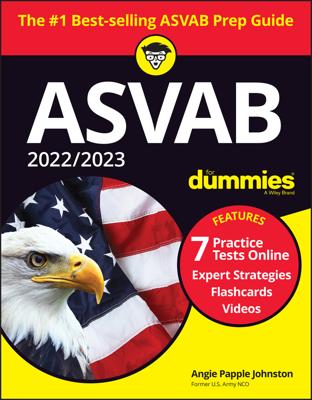The military has a saying, “Train as you fight.” The same is true of the ASVAB. If you plan to take the pencil-and-paper version of the ASVAB, concentrate most of your efforts on the written practice tests. If you’ll be taking the CAT-ASVAB, spend most of your time practicing with online tests.
Get a sense of how long it takes you to complete each subtest so you know how much time you have to spend on educated guessing. After you complete the first practice test, check your answers to see where you need improvement.When you study for the ASVAB, fall in line with these study habits to make the most of your time:
- Focus on the subtests that matter to you. If you have a clear interest in pursuing a career in electronics, the Electronics Information subtest should be at the top of your list to ace. Although you’ll want to make sure all your line scores are good (in case you retrain or your desired job isn’t available), focusing on your expertise in certain areas of interest makes you a more desirable candidate.
- Concentrate on subject areas that need improvement. It’s human nature to find yourself spending your study time on subject areas that you have an interest in or that you’re good at. If you’re a whiz at fixing cars, don’t waste your time studying auto information. You’re already going to ace that part of the test, right? On the other hand, if you had a hard time in math during your high school years, you need to spend extra time brushing up on your arithmetic skills.
- Be a loner. You may want to study with a partner now and then so the two of you can brainstorm answers and quiz each other, but most of your studying should be done on your own.
- Try to reduce distractions. Always study in a well-lit, quiet area away from pets, screaming babies, and the TV.
- Study in long blocks of time. Studying for an hour or two once or twice a day is much more effective than 15 minutes six times a day.
- Keep study breaks short. A few minutes every hour is sufficient. Don’t ignore breaks completely, however. Studies show that taking short breaks improves how well you’re able to remember information.
- Practice the actual act of test-taking. Practice marking answers correctly on the answer key and time yourself to see how long it takes you to answer questions.
If you’re unsure of how to begin studying for the ASVAB. There you’ll find a 12-week study strategy.
After you do some additional studying, take the second practice exam. Again, try to duplicate testing conditions. Check your answers. Compare your scores to the scores from your first test. Have you improved? If so, continue studying as you have been. If not, reconsider how you’re studying or whether you’re setting aside enough time to study. A school counselor or teacher can give you additional study pointers. Continue practicing with the next few tests.A couple of weeks before the ASVAB, take the next-to-last practice test. Brush up on any of those nagging areas that still give you fits. Check to see which areas you need help with and spend more time studying those areas.
A week before your test date, take the last test. This test helps you calm your nerves before taking the ASVAB — how the test works will be fresh in your mind.
Don’t waste time memorizing the practice questions in this guide or any other ASVAB study guide. You won’t see the same questions on the ASVAB. Use this guide and the sample tests for two purposes:
- To determine the subject areas in which you need to improve: Use the tips and techniques, along with standard study materials (like high school textbooks), to improve your knowledge of that specific subject.
- To familiarize yourself with the types of test questions and the way they’re presented on the test: Getting a good idea of what all the subtests look like will improve your test-taking speed. You won’t have to spend time trying to figure out how a question looks. You can spend your time answering the question.

